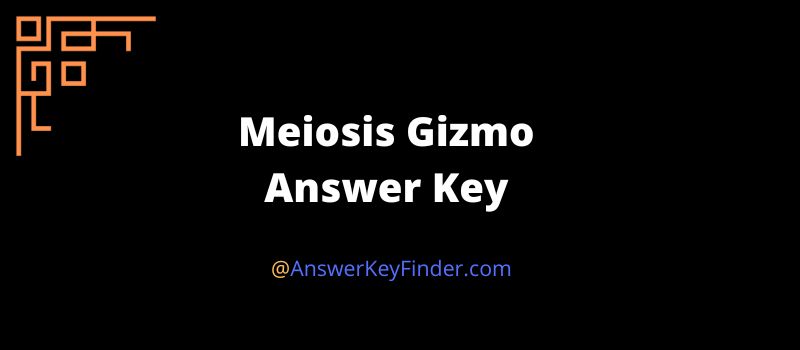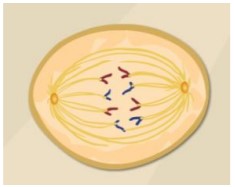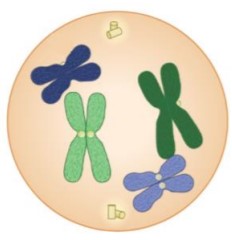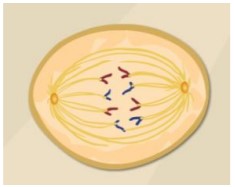Interested in knowing FREE answers key for Meiosis Gizmo questions?
If YES, check below for the right solutions…
Meiosis Gizmo Answer Key (Student Exploration)
NOTE: All answers are checked twice before publishing them to you. So, please share if it helps you.
Vocabulary: anaphase, chromosome, crossover, cytokinesis, diploid, DNA, dominant, gamete,
genotype, germ cell, haploid, homologous chromosomes, interphase, meiosis, metaphase,
mitosis, ovum, phenotype, prophase, recessive, sister chromatid, sperm cell, telophase, zygote.

Prior Knowledge Questions & Answers (Do these BEFORE using the Gizmo)
Q.1. During mitosis, a single cell divides to produce two daughter cells. What must happen in the
original cell so that each of the daughter cells has a complete set of chromosomes?
Ans: The cells copy or replicate their chromosomes, and then split the copied chromosomes equally to make sure that each daughter cell has a full set.
Q.2. During sexual reproduction, two sex cells fuse to create a fertilized cell with a complete set of chromosomes. What must be true about the number of chromosomes in each sex cell?
Ans: There must be 46 chromosomes in each cell.
Meiosis Gizmo Warm-up Warm-Up Questions & Answers
Meiosis is a type of cell division that results in four daughter cells with half as many chromosomes as the parent cell. These daughter cells mature into gametes or s*x cells.

In the Meiosis Gizmo, you will learn the steps in meiosis and experiment to produce customized s*x cells and offspring.
On the STEPS tab, click Male. You are looking at a germ cell or a cell that will undergo meiosis to become gametes.
Q.1. Read the description of interphase at the bottom of the Gizmo. What happens to the cell at the beginning of the interphase?
Ans: It groans and synthesizes the mRNA
Q.2. Click on the DNA in the nucleus of the cell. Describe what happens.
Ans: It copies and expands the cell.
Q.3. Why is it necessary for the cell to grow and duplicate its DNA before the start of meiosis?
Ans: So, it can store all the chromosomes in it.
Gizmo Meiosis Answers – Activity A

Introduction: Unlike mitosis, which produces two identical daughter cells from one parent cell,
meiosis creates four unique daughter cells with half the amount of DNA as the parent cell.
Question: How does meiosis create four daughter cells from one parent cell?
Q.1. Observe: (Prophase I) Click on the nucleus to break it down then click on the DNA to condense it into chromosomes. Drag the centrosomes to the top and bottom of the cell.
A. How many chromosomes does this cell have?… Ans: 46. Each chromosome consists of a pair of sister chromatids, two identical strands of DNA that are formed when DNA is replicated during interphase.
B. On the image to the right, draw two lines connecting the pairs of homologous chromosomes (chromosomes of similar size with a matching set of genes). In the Gizmo, drag the homologous chromosomes together. Click Continue… Ans: (check the image below)…

Q.2. Observe: (Metaphase I and Anaphase I) – Drag the groups of homologous chromosomes to
the metaphase plate, then drag spindle fibers from each of the centrosomes to the chromosomes. Click the centrosome to pull the chromosomes apart. How do the chromosomes separate in anaphase I?
Ans: The chromosomes are separated by a spindle fiber

Q.3. Compare: An image of the anaphase step in mitosis is shown above.
A. How does anaphase I in meiosis differ from anaphase in mitosis?… Ans: They connect instead of full apart.
B. At the end of anaphase I (meiosis), how many chromosomes are on each side?… Ans: 63
Q.4. Observe: Telophase I and cytokinesis are the final steps of the first half of meiosis.
A. Describe what happens when you click on the chromosomes during telophase I… Ans: They separate.
B. Click and drag on the contractile ring. Describe what happened during cytokinesis… Ans: They become different separate cells.
Q.5. Observe: Go through the steps of the second half of meiosis until you reach the end of
telophase II, following the instructions at the top right corner. As you proceed, answer the
questions below. Use the Back button if you need to see a step again.
A. Before prophase II begins, does the DNA in the cell duplicate itself?… Ans: No. Interphase
happens only once.
B. During metaphase II, do homologous chromosomes pair up as in metaphase I?… Ans: No.
C. How does anaphase II differ from anaphase I?… Ans: Anaphase one is in the parent cell whereas anaphase 2 takes place in the daughter cell.
D. At the end of anaphase II, how many chromatids are on each side of the cell?… Ans: 8
E. After cytokinesis, how many cells have been formed from the parent cell?… Ans: 4
F. Are all of the cells the same size?… Ans: Yes.
The original parent cell is called diploid because it contains a complete set of homologous chromosome pairs. Each of the four daughter cells is haploid, meaning that each contains half of the original parent cell’s chromosomes. Each daughter cell contains one chromatid from each homologous pair.
Q.6. Observe: Click on the spermatids. Spermatids that formed from meiosis will develop into mature male gametes called sperm cells. Sketch a mature sperm cell in the space to the right. Mature sperm cells have only a small amount of cytoplasm and use their flagella, or “tails,” to propel themselves forward. Sperm are designed for one purpose, to deliver genetic material to the egg cell during fertilization
Ans: (check below image for answer)

Gizmo Meiosis Answers – Activity B

Introduction: Although both male and female gametes contain genetic material from the parent
organism, they perform different functions. A male gamete delivers genetic material to a female
gamete. The fertilized female gamete called a zygote, then grows into the offspring.
Question: What are the differences in meiosis between male and female cells?
Q.1. Compare: Click on the Female button. For the female cell, proceed through meiosis until
you reach the end of anaphase I. Up to this point, did you notice any differences between the development of male and female gametes? Explain.
Ans: Yes… The male one started as sperm and the female one started as an egg.
Q.2. Compare: Proceed through telophase I and cytokinesis I.
A. What do you notice about the size of the two resulting cells?… Ans: They look uneven but smaller though.
B. How does this compare to the two cells at the end of telophase I and cytokinesis I in
male cells?… Ans: They end as smaller sperm but bigger.
Q.3. Compare: Continue through meiosis until you finish telophase II and cytokinesis II.
A. What do you notice about the four cells now?… Ans: They are very similar to see but one is bigger.
B. What is the largest cell called?… Ans: OVA. The ovum is the largest cell in the human body. In contrast, the sperm cell is the smallest cell in the human body.
C. What are the small cells called?… Ans: Polar bodies are small cells that develop as a byproduct of meiosis in females. In humans and most other animals, these cells play no significant role and soon die.
Q.4. Think and discuss: Why do you think egg cells are large and sperm cells are small?
Ans: The egg cell is the main carrier and the sperm cell is the delivery.
Gizmo Meiosis Answers – Activity C

Introduction: The activities above show that organisms can produce at least four different gametes. In reality, organisms can produce millions of genetically unique gametes.
Question: How can meiosis create an unlimited number of unique gametes?
Q.1 Experiment: Use the following abbreviations for the chromosomes. Dark green – DG; Light green – LG; Dark purple – DP, Light purple – LP. Choose a Male or Female cell.
A. Proceed through meiosis to anaphase I. Which chromosomes went up and which went down?… Ans: Up: DG, DP… Down: LP, LG
B. Click Back and run anaphase I again a few times. Did the results ever change? Explain… Ans: No. Because they must go in one direction for Meiosis.
C. Chromosomes are distributed randomly during anaphase I. What are the possible chromosome combinations in the two daughter cells? (Use DG, LG, DP, and LP.)… Ans: DG DP, LG LP, DP LG, LP DG
Q.2. Experiment: Click Reset. Choose a Male or Female cell. Proceed through meiosis until the chromosomes are condensed in Prophase I. Drag the LG (light green) chromosome to the Allele map on the left. This shows the alleles or variations of a gene) that are present on the chromosome. A genotype is a list of alleles. The genotype of the LG chromosome, for example, is EEFFGGHHJJ.
A. What are the genotypes of the remaining chromosomes?… Ans: DG:EEFFGGHHJJ LP:ABBCCDD DP:aabbccdd
B. After moving the centrosomes, drag the pairs of homologous chromosomes together. Click on a chromosome. What happens?… Ans: It opens. When homologous chromosomes are paired up, they can exchange sections. This exchange of genes is called a crossover.
C. Click on several segments to create crossovers, and then click Continue. Proceed to Anaphase I. Drag each chromosome to the Allele map and write its genotype… Ans: LG:EeFfGGHHjJ DG:eEfFgghhJj LP:aABBCcDd DP:AaBBcCdD
Q.3. Think and discuss: In this Gizmo, only one crossover is allowed in each segment. In reality,
crossovers can occur at almost any point along the chromosome. How does the random distribution of chromosomes and crossovers create more variation in the resulting gametes?
Ans: It can mix in the cells creating endless combinations
Q.4. Explore: Meiosis is a complicated process. What happens when something goes wrong?
A. Click Reset and choose a male or female cell. Click Skip. Describe what would happen if meiosis occurred without DNA replication… Ans: They miss genetic material.
B. Click Back. Proceed through meiosis until the chromosomes are lined up along the metaphase plate. Click Skip. Describe what would happen if the chromosomes did not attach to spindle fibers during metaphase I… Ans: The daughter cells have inconsistent materials…
C. Click Back. Proceed through meiosis until the chromatids are connected to spindle fibers at Anaphase II. Click Skip. Describe what would happen if sister chromatids were not pulled apart at anaphase II… Ans: They don’t end up in the same gamete.
D. Click Back. Proceed through meiosis until cytokinesis II. Click Skip. Describe what would happen if cytokinesis did not occur… Ans: Doubles the amount of material.
During meiosis, there are checkpoints that stop cell division if anything goes wrong. However, these checks do not always work. Abnormal cell division during meiosis can lead to genetic disorders. Trisomy 21 (Down syndrome), for example, occurs when there is an extra copy of chromosome 21 in one of the sex cells.
Gizmo Meiosis Answers – Activity D

Introduction: Earlier, you learned how crossovers can result in genetically diverse gametes. In this activity, you will perform crossovers in parent cells undergoing meiosis and combine the resulting gametes to produce offspring with specific genotypes.
Question: How can offspring be created that have a specific phenotype and genotype?
Q.1. Explore: The EXPERIMENTATION tab shows a simplified fruit fly genome, with a single pair
of homologous chromosomes. Each chromosome has genes that control wing shape, body-color, antenna type, and eye color. The uppercase alleles are dominant and the lower case alleles are recessive. The allele key is given at the lower left. (Note that real fruit flies have eight chromosomes and many more genes.)
A. Click Reset. Without creating any crossovers, click Divide into gametes. What are the possible genotypes of the gametes?… Ans: CCCCLLRR or ccbbllrr
B. Drag a gamete from each parent into the box below to create a zygote. What are the different combinations of possible offspring genotypes?… Ans: (CCBBLLRR) (CcBbLlRr) (ccbbllrr)
C. Click Show phenotype for each combination. What are the resulting phenotypes?… Ans: Yellow fly or black fly
Q.2. Experiment: Click Reset. You can create crossovers by clicking on the middle chromatids in each of the parent cells.
A. Create a gamete with the genotype C b l r. First, click on the c gene in one of the parent cells to create the crossover. Then, click Divide into gametes. Did you create a gamete with the genotype C b l r?… Ans: Yes
B. Click Reset. Create a gamete with the genotype: c b L R. How many crossovers were needed to create this gamete?… Ans: 3
When a crossover occurs, the entire portion of genetic material is swapped between the two homologous chromosomes, so gene C is swapped along with gene B and gene R is swapped along with gene L.
C. Click Reset. Create a c B L r gamete. How many crossovers were needed?… Ans: 4 crossovers
Q.3. Challenge: Select the Challenge radio button. Make sure that Target offspring 1 is selected in the dropdown menu. Target offspring 1 is a fruit fly with normal wings (cc), a black body (bb), normal antenna (ll), and red eyes (Rr). Because the offspring receives one chromatid from each parent, each chromatid should come from a different parent.
A. Using the Gizmo, create a fruit fly with the correct genotype. Explain how you did it… Ans: I crossed over 4 times on one parent and 1 time on the other.
B. Is there another way to get the correct phenotype, but not the correct genotype?… Ans: No
Q.4. Challenge: Use the dropdown menu to switch to the next target offspring. While creating target offspring 2-5, fill out the table below. Also, To produce target offspring 5, why were two crossovers needed on one chromatid arm?
Ans: There were two crossovers needed on one chromatid arm is to make one the “r” recessive… check below table for answers

Q.5. Think and discuss: Suppose there are two homologous chromosomes. Each chromosome contains a single mutant allele in different parts of the chromosome. How can crossovers be beneficial in this situation? (Hint: How can you create a single, mutation-free chromosome?)
Ans: Crossovers can be beneficial in this situation because with crossover single mutant allele can be combined to make a normal allele.
Above are the correct answers for the Gizmo topic “Meiosis“. Now let us bring you a glimpse of Meiosis & its different processes in the coming session.
Or would you like to explore other topics associated with Gizmos? >>Find all other Gizmo Answers<<
About Meiosis
Meiosis is the process of cell division where a single diploid (2n) cell divides to produce four haploids (1n) cells with half the number of chromosomes as the original cell.
The two-part process of meiosis is how cells divide when an organism’s DNA is replicated in preparation for fertilization. The end result of the process is four gametes, which are sperm or egg cells.
The first part of meiosis, Meiosis I, occurs in a diploid cell. Diploid cells have two homologous copies of each chromosome, with each copy coming from the organism’s mother and father. Meiosis I produces two haploid cells, which have only one homologous copy of each chromosome. The chromosomes are separated so they can’t be identical anymore.
The second part of meiosis, Meiosis II, occurs in a haploid cell. Haploid cells only have one homologous copy of each chromosome. Meiosis II produces two daughter cells with the same number of chromosomes as the diploid parent cell.
The actual process of meiosis is random and complex due to crossing-over (when sections of non-sister chromatids exchange DNA) and independent assortment (the random distribution of chromosomes to gametes).
Although meiosis I and meiosis II are essentially the same, they do differ in how crossing over occurs. Meiosis I has no crossing over while Meiosis II does have a crossing over.
Thank you for reading! we hope the summary has provided you with some useful information about Meiosis that may help in answering the above questions as well.
More References:
=> https://www.yourgenome.org/facts/what-is-meiosis
=> https://en.wikipedia.org/wiki/Meiosis
Hope you get the Gizmo Meiosis Answer Key for levels A, B, C & D by following our answers above. Share with your batchmates if you find it helpful.

Hi, I’m Thomas, and I’ve been a teacher for over 10 years and have taught students at all levels. I created this blog to really help students get ahead of their exams as well as provide helpful guides on various courses.

Nicely answered.
Good to hear that
Thank you. God bless you.
You are welcome